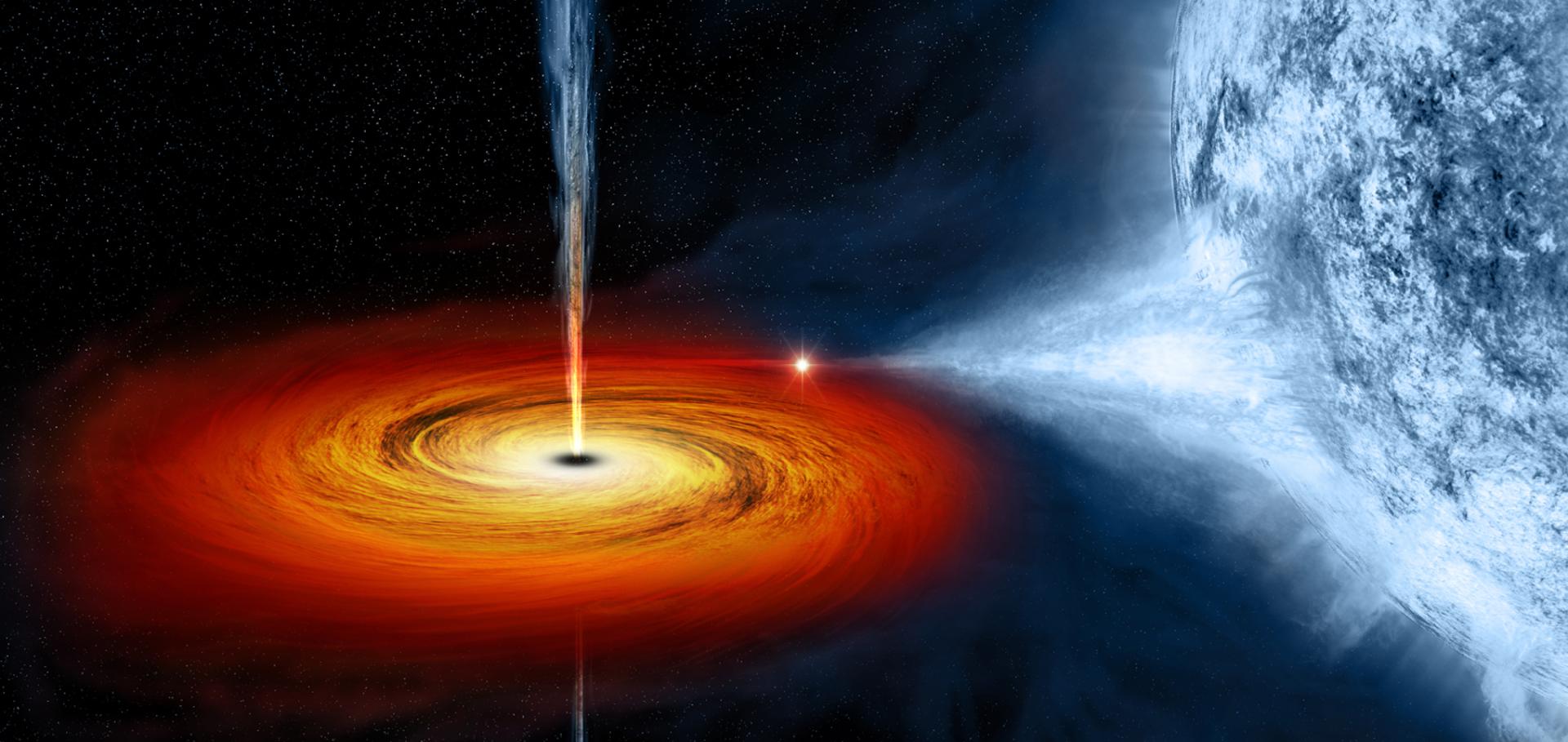Relativistic precessing jets powered by an accreting neutron star
Monthly Notices of the Royal Astronomical Society: Letters Oxford University Press 544:1 (2025) L37-L44
Abstract:
Precessing relativistic jets launched by compact objects are rarely directly measured, and present an invaluable opportunity to better understand many features of astrophysical jets. In this Letter we present MeerKAT radio observations of the neutron star X-ray binary system (NSXB) Circinus X-1 (Cir X-1). We observe a curved S-shaped morphology on scales in the radio emission around Cir X-1. We identify flux density and position changes in the S-shaped emission on year time-scales, robustly showing its association with relativistic jets. The jets of Cir X-1 are still propagating with mildly relativistic velocities from the core, the first time such large scale jets have been seen from a NSXB. The position angle of the jet axis is observed to vary on year time-scales, over an extreme range of at least . The morphology and position angle changes of the jet are best explained by a smoothly changing launch direction, verifying suggestions from previous literature, and indicating that precession of the jets is occurring. Steady precession of the jet is one interpretation of the data, and if occurring, we constrain the precession period and half-opening angle to yr and , respectively, indicating precession in a different parameter space to similar known objects such as SS 433.A relativistic jet from a neutron star breaking out of its natal supernova remnant
Monthly Notices of the Royal Astronomical Society Oxford University Press 541:4 (2025) 4011-4024
Abstract:
The young neutron star X-ray binary, Cir X-1, resides within its natal supernova remnant and experiences ongoing outbursts every 16.5 d, likely due to periastron passage in an eccentric orbit. We present the deepest ever radio image of the field, which reveals relativistic jet-punched bubbles that are aligned with the mean axis of the smaller scale jets observed close to the X-ray binary core. We are able to measure the minimum energy for the bubble, which is around = erg. The nature and morphological structure of the source were investigated through spectral index mapping and numerical simulations. The spectral index map reveals a large fraction of the nebula’s radio continuum has a steep slope, associated with optically thin synchrotron emission, although there are distinct regions with flatter spectra. Our data are not sensitive enough to measure the spectral index of the protruding bubbles. We used the pluto code to run relativistic hydrodynamic simulations to try and qualitatively reproduce the observations with a combined supernova-plus-jet system. We are able to do so using a simplified model in which the asymmetrical bubbles are best represented by supernova explosion which is closely followed (within 100 yr) by a phase of very powerful jets lasting less than 1000 yr. These are the first observations revealing the initial breakout of neutron star jets from their natal supernova remnant, and further support the scenario in which Cir X-1 is a younger relation of the archetypal jet source SS433.Joint Radiative and Kinematic Modelling of X-ray Binary Ejecta: Energy Estimate and Reverse Shock Detection
Monthly Notices of the Royal Astronomical Society Oxford University Press (OUP) (2025) staf1085
Abstract:
Abstract Black hole X-ray binaries in outburst launch discrete, large-scale jet ejections which can propagate to parsec scales. The kinematics of these ejecta appear to be well described by relativistic blast wave models original devised for gamma-ray burst afterglows. In previous kinematic-only modelling, a crucial degeneracy prevented the initial ejecta energy and the interstellar medium density from being accurately determined. In this work, we present the first joint Bayesian modelling of the radiation and kinematics of a large-scale jet ejection from the X-ray binary MAXI J1535-571. We demonstrate that a reverse shock powers the bright, early ejecta emission. The joint model breaks the energetic degeneracy, and we find the ejecta has an initial energy of E0 ∼ 3 × 1043 erg, and propagates into a low density interstellar medium of nism ∼ 4 × 10−5 cm−3. The ejecta is consistent with being launched perpendicular to the disc and could be powered by an efficient conversion of available accretion power alone. This work lays the foundation for future parameter estimation studies using all available data of X-ray binary jet ejecta.Blast waves and reverse shocks: from ultra-relativistic GRBs to moderately relativistic X-ray binaries
Monthly Notices of the Royal Astronomical Society Oxford University Press 539:3 (2025) 2665-2684
Abstract:
Blast wave models are commonly used to model relativistic outflows from ultra-relativistic gamma-ray bursts (GRBs), but are also applied to lower Lorentz factor ejections from X-ray binaries (XRBs). Here, we revisit the physics of blast waves and reverse shocks in these systems and explore the similarities and differences between the ultra-relativistic () and moderately relativistic () regimes. We first demonstrate that the evolution of the blast wave radius as a function of the observer frame time is recovered in the on-axis ultra-relativistic limit from a general energy and radius blast wave evolution, emphasizing that XRB ejections are off-axis, moderately relativistic cousins of GRB afterglows. We show that, for fixed blast wave or ejecta energy, reverse shocks cross the ejecta much later (earlier) on in the evolution for less (more) relativistic systems, and find that reverse shocks are much longer lived in XRBs and off-axis GRBs compared to on-axis GRBs. Reverse shock crossing should thus typically finish after 10–100 of days (in the observer frame) in XRB ejections. This characteristic, together with their moderate Lorentz factors and resolvable core separations, makes XRB ejections unique laboratories for shock and particle acceleration physics. We discuss the impact of geometry and lateral spreading on our results, explore how to distinguish between different shock components, and comment on the implications for GRB and XRB environments. Additionally, we argue that identification of reverse shock signatures in XRBs could provide an independent constraint on the ejecta Lorentz factor.
A relativistic jet from a neutron star breaking out of its natal supernova remnant
Monthly Notices of the Royal Astronomical Society, Volume 541, Issue 4, August 2025, Pages 4011–4024
Abstract:
The young neutron star X-ray binary, Cir X-1, resides within its natal supernova remnant and experiences ongoing outbursts every 16.5 d, likely due to periastron passage in an eccentric orbit. We present the deepest ever radio image of the field, which reveals relativistic jet-punched bubbles that are aligned with the mean axis of the smaller scale jets observed close to the X-ray binary core. We are able to measure the minimum energy for the bubble, which is around 10^45 erg. The nature and morphological structure of the source were investigated through spectral index mapping and numerical simulations. The spectral index map reveals a large fraction of the nebula’s radio continuum has a steep slope, associated with optically thin synchrotron emission, although there are distinct regions with flatter spectra. Our data are not sensitive enough to measure the spectral index of the protruding bubbles. We used the pluto code to run relativistic hydrodynamic simulations to try and qualitatively reproduce the observations with a combined supernova-plus-jet system. We are able to do so using a simplified model in which the asymmetrical bubbles are best represented by supernova explosion which is closely followed (within 100 yr) by a phase of very powerful jets lasting less than 1000 yr. These are the first observations revealing the initial breakout of neutron star jets from their natal supernova remnant, and further support the scenario in which Cir X-1 is a younger relation of the archetypal jet source SS433.


